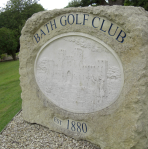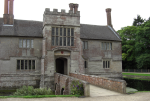Guest post by Janine Barchas
To fully understand Jane Austen, hiking boots are a must.
The research for my book Matters of Fact in Jane Austen: History, Location, and Celebrity led me (and, occasionally, my students and family members) to a number of eighteenth-century landscapes, castles, and country homes in England. We visited locations with probable connections to Jane Austen’s stories—because of a leading name, a reference to setting, or a possible historical context. Austen’s own geographical precision and historicist namedropping became the crumb trail for our literary archeology.
Hearing my daughter tell it, you’d think that I dragged the poor child “for miles” through “pouring rain” to photograph “some castle or overgrown garden in the middle of Yorksomethingorrather.” (Just for the record, it only stormed heavily that one time in Wentworth and then I did share the umbrella.)
We started in the city of Bath. In Austen’s Northanger Abbey, the naïve young heroine is escorted to Bath by a kindly Mr. and Mrs. Allen, in whose company she gets mistaken for a rich heiress. This case of mistaken identity may have a basis in historical fact. Bath’s wealthiest eighteenth-century residents had been a Mr. and Mrs. Allen who lived at Prior Park. This great Allen estate was in transition during precisely the years that Austen first drafted her novel (her sister pointed to 1798 and 1799).
In addition to building this grand Palladian mansion and landscape garden on the sloping hillside of Bath for all to see, Ralph Allen (1693-1764)—postal entrepreneur, stone mogul, and beloved philanthropist—also erected a prominent gothic folly along the city’s amphitheatrical setting that was visible from Austen’s own residence at Number 4 Sydney Place. With geographical precision about Bath that takes her characters deftly past the Sham Castle and a heroine who comically yearns to see a “real castle,” Austen nods to Ralph Allen’s legacy. Restored in 1921, his Sham Castle still stands, surrounded by a golf club that boasts of the folly in its signage.
The picturesque ruins of Farleigh Hungerford Castle lie just seven miles from Bath, which is exactly the same distance from the city as that traveled by John Thorpe’s carriage on his botched attempt to show the heroine a “real castle.” Already a popular tourist site in Austen’s time, Farleigh Hungerford features in many turn-of-the-century guidebooks about Bath, including one owned by Austen’s family and annotated in her hand.
Today it is an English Heritage site. The close resemblance between Catherine’s fantasies of General Tilney as a wife-killer and the reality of the crimes committed by Sir Walter Hungerford during the reign of Henry VIII (for years he kept his wife locked up in what locals call “The Lady Tower”) suggests how Northanger Abbey may spoof the Gothic novel with genuine English history, slyly demonstrating that real-world events can be as bizarre as gothic invention.
In Buckinghamshire, about 25 miles east of Oxford, we visited the historic home of the Dashwood family at West Wycombe Park. In the middle of the eighteenth century, “the family of Dashwood” gained a reputation as England’s most notorious hellraisers. Sir Francis Dashwood (1708-1781), 2nd Baronet and Lord Le Despencer, led a group of high-profile libertines whose decades of bacchanals and mock-Catholic drinking rituals earned it the label Hell-Fire Club. Sir Francis’ Italianate villa and provocative landscape gardens, with its suggestive female shapes, naughty statues, and notorious Hell Fire Caves, continues to attract a steady stream of visitors and film crews. (N.B.: The garden was heavily edited and tamed in the Victorian era, so those in search of Dashwood’s famed priapic statuary will be disappointed!) The reputation of the Dashwoods in 1811 makes Austen’s choice of name for her central family in Sense and Sensibility a bold choice—one with piquancy and interpretive risk.
On the other side of this reputational spectrum lies Baddesley Clinton in Warwickshire, just 13 miles west of Stoneleigh Abbey, where Austen stayed with relatives. Baddesley Clinton is the historic home of the Ferrers/Ferrars family, known for their steadfast Catholicism and staunch loyalties. The house is a rare example of a surviving medieval manor, with a crenellated gatehouse, moat, bridge, narrow rooms, and stained-glass windows. Everything seems as if dipped in amber during a former age. The dark, moated hunk of grey brick in which the Ferrers/Ferrars family lived is the antithesis of the Dashwoods’s airy eighteenth-century villa at West Wycombe, with its colonnade and bright yellow façade surrounded by open landscape. To paraphrase P.G. Wodehouse, both locales are positively soggy with British atmosphere, but whereas Baddesley Clinton signals historical continuity, West Wycombe breaks with convention (and propriety).
Emma, The Watsons, Pride and Prejudice, and Persuasion share a central allusion to arguably the grandest of Britain’s country estates, namely Wentworth Woodhouse in Yorkshire—home to the high-flying Woodhouse, Watson, Fitzwilliam, D’arcy, and Wentworth families since the middle ages. Our modern familiarity with the Kennedy name neatly resembles the overwhelming celebrity of the Wentworths in Austen’s day, excepting perhaps that the Wentworths held the political spotlight across centuries. Today, the enormous house is privately owned and not open to visitors, although the current owner has announced plans for a hotel and spa by 2015. The vast grounds of the estate, meanwhile, can already be enjoyed via public walking paths. Also, a small section of its trend-setting eighteenth-century landscape garden, about which Jane Austen may have known a good deal, is a thriving Garden Centre.
A mere six miles away lies Wentworth Castle, the eighteenth-century pride of the Earl of Strafford. In Austen’s lifetime the estate fell to an obscure and distant relative named, like Austen’s valiant captain in Persuasion, Frederick Wentworth, who then became the third and last Earl of Strafford. Of course Austen is not known to have ever travelled to Yorkshire.
And then there is the stubborn fact that in Persuasion, the toadying Sir Walter Elliot expressly dismisses any possible connection between Captain Frederick Wentworth, the fiction’s naval hero, and the Yorkshire Wentworths: “Mr. Wentworth was nobody… nothing to do with the Strafford family.” Nonetheless, the prominent cameo appearances of so many Wentworths in Austen’s work contradict Sir Walter’s dismissal—turning a disclaimer into a pointer. After the real Frederick Wentworth’s death in 1799, his estate passed somewhat contentiously into the Vernon branch—another name borrowed by Austen for her protagonist in Lady Susan, where fictional Vernons squabble over a family castle in possible imitation of their real-world namesakes. Wentworth Castle, which currently houses a college, is undergoing ambitious renovations and has opened up its historic gardens to visitors.
 Janine Barchas is an associate professor of English at the University of Texas, Austin, and the author of the recently published Matters of Fact in Jane Austen as well as Graphic Design, Print Culture, and the Eighteenth-Century Novel.
Janine Barchas is an associate professor of English at the University of Texas, Austin, and the author of the recently published Matters of Fact in Jane Austen as well as Graphic Design, Print Culture, and the Eighteenth-Century Novel.








